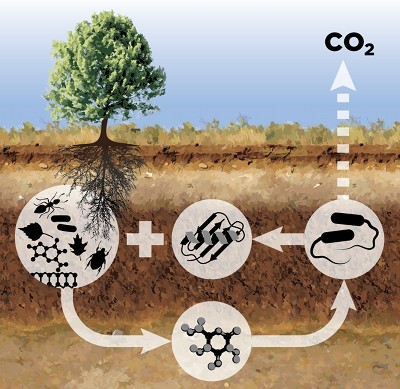
Oak Ridge National Laboratory’s new carbon cycling model could help scientists understand the role of soil in climate change by tracking the microbial processes that break down carbon-rich materials. (Graphic submitted by ORNL)
A new model developed at Oak Ridge National Laboratory helps scientists understand the role that soil will play in future climate change, a press release said.
Predicting climate change depends heavily on the cycling of carbon dioxide, which is found in four main reservoirs: the atmosphere, biosphere, oceans, and soil, the release said.
ORNL’s model was designed to replace traditional soil carbon cycling models. The press release said it better accounts for the carbon dioxide-releasing activity of microbes in the ground.
“Soil is a big reservoir of carbon,” said co-author Melanie Mayes of ORNL’s Environmental Sciences Division. “And most of the soil carbon cycling models in use today are so vastly simplified that they ignore the fact that decomposition is actually performed by microbes.”
In a paper published in Ecological Applications, the journal of the Ecological Society of America, ORNL researchers integrated data from scientific literature on carbon degradation in soil to form the Microbial-Enzyme-mediated Decomposition, or MEND, model.
“Our MEND model does a better job of representing the mechanisms of soil carbon decomposition than existing models,” Mayes said.
Here’s more information from the press release:
ORNL’s comprehensive model accounts for how the different forms of carbon in soil, or “pools,” react with extracellular enzymes excreted into the soil by microbes, allowing scientists to understand how quickly carbon is moving through soils.
The model simulates the carbon cycle, beginning after a decaying plant or animal releases carbon-rich materials into the soil. The organic material is degraded by enzymatic reactions, releasing dissolved carbon molecules that can be absorbed by microbes for growth or metabolism. These processes ultimately result in the release of carbon dioxide.
ORNL’s MEND model is the first model able to track degradation by accounting for most of the relevant processes and by estimating the parameters based on a comprehensive literature review. This model, which is based on the physiological functions of microbes, accounts for how temperature affects the ability of microbes to emit carbon dioxide. Soil can either store or release carbon depending on how rapidly carbon-rich materials in the soil are decomposed.
“What we think will happen is that as temperature goes up, microbial physiology will change, altering their ability to break down carbon chains and release carbon dioxide into the atmosphere,” Mayes said. “If our models don’t account for this process, then our ability to predict future climate change will be less realistic.”
For the next six to eight months, ORNL’s team will run laboratory-scale experiments to ensure that the MEND model accurately represents the decomposition of carbon compounds in soils. Eventually, team members hope to incorporate their model into the publicly available supercomputing program called the Community Land Model, a module used in the Community Earth System Model that helps researchers predict future climate change.
The study was supported by ORNL’s Laboratory Directed Research and Development program, and model development will continue to be funded by DOE’s Office of Science.
Co-authors of the paper include Mayes and ORNL’s Gangsheng Wang and Wilfred Post.
Tj says
So as the temperature goes up CO2 is absorbed into the soil.
The earth is self regulating.
Actually, a study I just read confirms this theory. CO2 is decreasing in the stmosphere.
The state paid “experts” who base their grants or income on Man made global warming need to find another job–like lawn care.
Peter Scheffler says
TJ,
Do you have a reference for the study you mention? I’d like to see that.
Tj says
Type “carbon sink” at Wikipedia. Search “reconstruction of the history of anthropogenic co2”— by S. Khatiwala, et al.
I am still looking for the article. I cannot cut and paste the above on this pad.
R. Scharf says
The press release, above, says nothing of the sort. In general, soils in cooler climates accumulate more organic carbon than those in warmer climates.